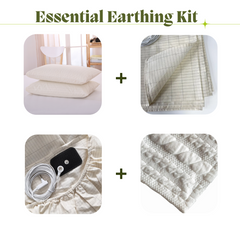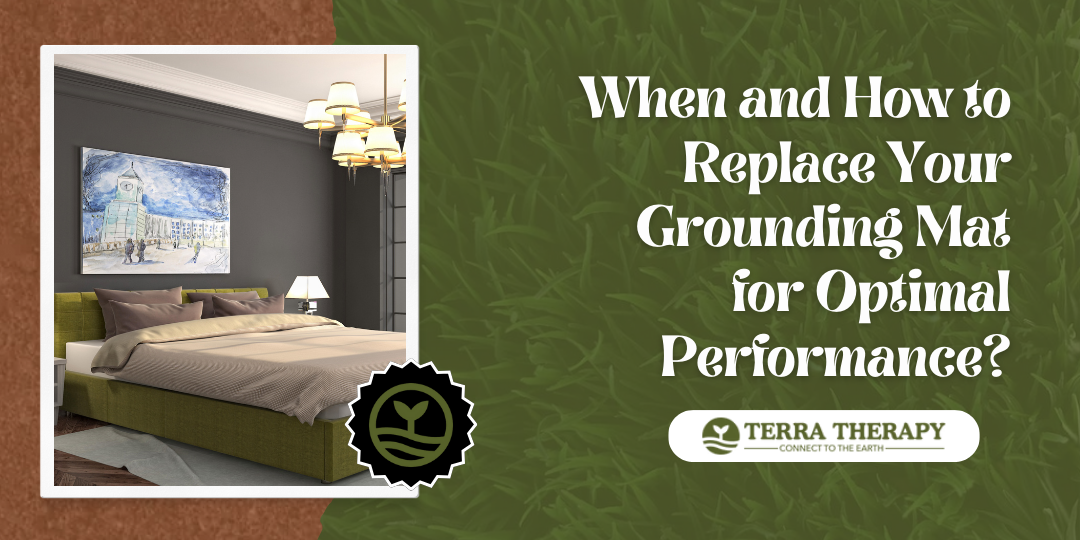Surprisingly, over 80% of people spend their days in environments that could benefit from a grounding mat or sheet.
Yet, only some understand its importance, how it works, or when to replace these products for optimal performance, mainly when used barefoot. Recognizing the signs that your grounding sheet or mat needs replacing is crucial for maintaining its effectiveness and ensuring it works properly.
This awareness leads to improvements in the products you rely on for grounding. Whether it's due to visible wear and tear or a noticeable decrease in energy levels, knowing when and how to replace your grounding mat products can significantly impact your health and well-being, healing stress and leading to improvements.
Key Takeaways
- Signs of Wear: Replace the mat if there are visible signs of wear, such as fraying or loss of conductivity.
- Decreased Effectiveness: If the grounding benefits diminish, it may indicate the need for a new mat.
- Regular Replacement: Typically, grounding mats should be replaced every couple of years for optimal performance.
Why Regularly Replace Your Grounding Mat for Optimal Functionality?
Grounding mat for bed, including those products designed for beds, serve as a bridge to the Earth's electrons, working to provide healing similar to walking barefoot.
They offer numerous health benefits, such as reducing inflammation, pain, and stress, improving sleep, and enhancing DS products. However, their effectiveness can diminish over time. This is why it's crucial to replace them regularly.
Wear and tear are the primary reasons for replacement. Regularly used grounding mats can develop cracks or tears that interfere with their conductivity. This damage affects the mat's ability to ground effectively and can become a safety hazard if wires become exposed.
Another factor is the buildup of oils and sweat from our bodies. These residues can create a barrier on the mat's surface, hindering its grounding capabilities. Regular cleaning helps, but more is needed to maintain optimal functionality over time.
When Is the Right Time to Replace Your Grounding Mat for Best Results?
Determining the optimal time to replace your grounding mat hinges on several key factors. Firstly, consider its usage frequency. Mats used daily on the ground wear out faster than those used less often. A general rule is to inspect your mat every six months for signs of wear and tear.
Visible damage such as cracks, thinning, or any structural compromise indicates it's time for a replacement. These defects can significantly hinder the mat's effectiveness in grounding you properly. If you start experiencing increased fatigue or the health benefits diminish, this also signals that the ground mat's functionality is declining.
Another critical aspect is the material quality of your grounding mat. High-quality ground mats can last longer, but they still require regular checks. Environmental factors like humidity and temperature changes can affect the lifespan of a grounding mat. Mats exposed to harsh conditions need more frequent replacements.
Ensuring the mat functions correctly is crucial for those relying on their grounding mats to reduce chronic pain. It's beneficial to track when you started using your current ground mat. This way, you can better gauge its performance over time.
There isn't a one-size-fits-all answer to when you should replace your grounding mat. It depends on how often you use it, where it's stored, and what signs of wear you observe. Being proactive about maintenance will help you achieve the best results from your grounding practice.
Where to Find Quality Replacement Grounding Mats for Enhanced Performance?
Finding the right replacement for best grounding mat can significantly boost your overall well-being and ensure you get the most out of this technology. High-quality grounding mats, especially those designed for beds, should come from reputable suppliers specializing in grounding and earthing products. These suppliers often conduct rigorous product testing to guarantee effectiveness and safety.
Online marketplaces are a primary source for these mats. Look for vendors with high ratings and positive reviews from customers who have experienced tangible benefits. Websites dedicated solely to grounding and earthing solutions often provide extensive information about each product, including its sourcing materials and user guidelines.
Specialty health stores may also stock grounding mats. They offer the advantage of speaking directly with knowledgeable staff about the product's benefits and how to integrate it into your lifestyle effectively.
For those seeking a grounding mat for bed, ensure the product is specifically designed for prolonged contact and comfort during sleep. These mats should facilitate uninterrupted grounding throughout the night, enhancing sleep quality and reducing inflammation.
Remember, quality matters more than price when it comes to health devices. Investing in a top-tier grounding mat ensures durability and sustained performance over time. Always verify product certifications and look for guarantees or return policies that protect your purchase.
How to Determine When Your Grounding Mat Needs Replacement?
Identifying the right time to replace your grounding mat for bed ensures you continue to enjoy its benefits without interruption. Over time, wear and tear can diminish a mat's effectiveness. Look for visible signs of aging, such as cracks or fraying edges. These physical indicators suggest the mat's surface is no longer conducive for optimal grounding.
Another sign is a change in your sleep quality or general well-being. If you've been using the best grounding mat for bed and notice you're not feeling as rested or rejuvenated upon waking, it might be time for a new one. Grounding mats lose their conductivity with use, affecting their performance.
It's also wise to test your mat's conductivity periodically. Some grounding mats come with testers, but if yours didn't, consider purchasing one separately. A sudden drop in conductivity levels is a clear signal that your mat needs replacing.
Lastly, consider the manufacturer's recommended replacement timeline. High-quality mats, like the best grounding mats, are designed to last but don't last forever. Adhering to the suggested replacement schedule helps maintain consistent benefits from your grounding practice.
What Factors Influence the Need to Replace Your Grounding Mat for Peak Performance?
Several factors can signal when to replace your grounding bed mat. Wear and tear is a primary consideration. Over time, the material of the grounding mat can degrade, affecting its conductivity.
This degradation compromises the mat's effectiveness in grounding the body and may necessitate replacement for optimal performance.
Environmental conditions also play a significant role. Extreme temperatures or moisture exposure can damage the mat's surface and internal components, reducing its grounding capabilities. Users living in humid climates or using their mats outdoors should be particularly vigilant.
The frequency of use impacts longevity as well. A nightly grounding bed mat will endure more wear than one used sporadically. It's crucial to monitor its condition regularly and assess any changes in performance.
Lastly, technological advancements may introduce more efficient grounding solutions. Staying informed about new developments can help you decide when an upgrade is beneficial for enhanced health benefits.
Why Prioritize Timely Replacement of Your Grounding Mat?
Timely replacing your grounding mat ensures optimal performance and maximizes the health benefits. Over time, wear and tear can compromise its effectiveness. This is crucial for products like bed grounding mats, where daily use is expected.
Grounding mats lose their conductivity with regular use. The materials break down, reducing their ability to transfer Earth's electrons to your body.
This degradation affects how well they reduce inflammation and improve sleep quality. It's not just about the physical condition of the mat. Its ability to connect you with the Earth's energy diminishes. This is why experts recommend keeping an eye on your mat's condition.
Moreover, advancements in grounding technology mean newer models offer better efficiency and durability. By replacing your mat regularly, you benefit from these improvements.
You'll find many grounding mats for bed that cater to different needs and preferences. Whether it's for therapeutic reasons or enhancing sleep quality, there's a product that fits.
In addition to maintaining effectiveness, timely replacement helps avoid potential safety risks associated with worn-out mats. Electrical components may become exposed over time, posing a hazard.
How Proper Replacement Enhances the Effectiveness of Your Grounding Mat?
Timely replacing your grounding mat ensures its effectiveness in conducting the Earth's electrons. These mats lose conductivity due to wear and tear, reducing their ability to ground you effectively. A fresh grounding sleeping mat has optimal conductivity, offering the full benefits of grounding from the moment you start using it.
Regularly replacing your grounding mats for sale also helps maintain hygiene. Mats can accumulate sweat, dust, and other contaminants that are not always visible. This buildup can interfere with the mat's ability to connect with your skin properly. By keeping your grounding equipment fresh, you ensure both cleanliness and efficiency.
Moreover, advancements in grounding technology mean newer mats often offer improved functionality and durability. Manufacturers continually refine their products based on feedback and research. Therefore, upgrading to a newer model can enhance your grounding experience through better materials and design.
What Steps to Take to Ensure Seamless Replacement of Your Grounding Mat?
Replacing your grounding mat can rejuvenate its effectiveness, as discussed earlier. To ensure a smooth transition, several steps are crucial. First, assess the condition of your current grounding sleeping mat. Look for visible wear and tear that might impair its functionality.
Next, research the latest models. Technology evolves, so newer versions may offer enhanced benefits. They could be more durable or provide better grounding effects. Make sure to read reviews and compare features.
Before disposing of the old mat, check if it's recyclable. Some materials can be environmentally harmful if not handled properly.
When installing the new grounding mat, follow the manufacturer's instructions carefully. This ensures optimal performance and safety. Placement is critical for adequate grounding; typically, under your bedsheet or workspace area works best.
Lastly, test the mat to confirm it's working as expected. Use a continuity tester if available. This step verifies that you're receiving the grounding benefits promised.
Conclusion
Ensuring your grounding mat remains in top condition is pivotal for reaping its full benefits. From understanding the optimal time for replacement to identifying quality mats, we've covered essential insights to maintain peak performance.
Your grounding mat is crucial in grounding techniques, directly influencing your health and well-being. By prioritizing timely replacement and adhering to the steps for a seamless transition, you ensure continuous protection against electrical discharges and enhanced physiological benefits.





